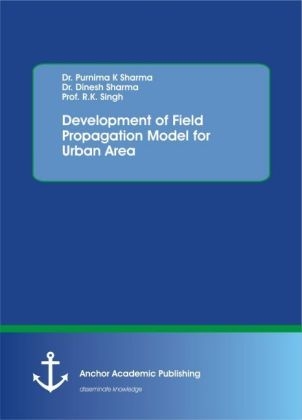
Development of Field Propagation Model for Urban Area
Anchor Academic Publishing (Verlag)
978-3-96067-126-8 (ISBN)
It has been found that severe climatic conditions disturb the propagation of electromagnetic signals at higher frequencies (greater than 30 MHz). The disturbance is mainly due to molecular absorption by oxygen for frequencies ranging between 60 and 118 GHz and due to water vapour in 22, 183 and 325 GHz bands. Rain and fog has the most significant impact, since the size of the rain drops is of the order of the wavelength of the transmitted signal. This results in energy absorption by the rain drops themselves, and as a secondary effect energy is scattered by the drops. The frequency selective absorption characteristics of the atmosphere can be approximated by a transfer function. In most of the practical channels when the signal propagates through the atmosphere the effect of many factors on the signal has to be considered along with the free space propagation channel assumption.
The main objective of this study is, therefore, to find out whether, and how, the different climatic conditions are influencing radio wave propagation in GSM frequency bands in general and in Narnaul, Haryana (India) in particular. To carry out this investigation, the records of radio wave propagation along with path loss during different climatic conditions have been analyzed. On the strength of these analyses, a propagation path loss model has been developed by proposing suitable correction factors due to different climatic conditions. The validation of this developed path loss model has been verified by taking reference models and by applying practically in different urban areas. The effect of these climatic conditions on the link budget has also been analyzed.
Text Sample:
CHAPTER 3 METHODLOGY FOR FIELD DATA COLLECTION, ANALYSIS & IST SIMULATION IN MATLAB:
In this chapter, total concentration is on data collection tools and ist analysis because field data collection is one of the major requirements of current research work. A number of data collection tools are available in the market in which TEMS data collection tool has been chosen for the current research work because it provides several advantages as compared to other data collection tools.
3.1 INTRODUCTION:
The excellence of the network is eventually evaluated by the satisfaction of the subscribers of the network. The measurement procedure is based on the use of a drive test system. A drive test simply means drive and test while roaming of a wireless network in a car. The drive test system provides the insight to the performance of a network particularly in terms of RF coverage. Drive tests give evaluation of the network performance the field. The testing procedure starts with selection of the area of the network where the drive tests require to be performed. The RF engineer must check the suitable kits that comprise mobile equipment (mobile phone), drive testing software (on a laptop), and a GPS (global positioning system) unit before going to the drive test. While the drive testing starts, two mobiles are used to make calls with a delay of few seconds. The third mobile is generally used for testing the coverage area. Using this third mobile the engineer makes one continuous call. If this call breaks it will go for another call. The main use of this testing process is to collect enough samples at a reasonable speed and in a reasonable time. It consists of investigating the RF coverage by looking at the key performance indicators, such as pilot power strength (Ec/Io), the forward transmit power (Tx), the downlink receive power (Rx) and the Frame Error Rate (FER) while roaming in the wireless network. In drive test evaluation, the BSs must be identified prior and then the route to be followed traced. This is very important in order to conduct a successful drive test in time [226]. The data collection tools used for drive test along with accessories is as follows:
Drive test tool (TEMS).
TEMS compatible mobile station with RF antenna and Serial Port data cable.
A laptop with minimum 256MB RAM.
Analysis software (Mapinfo, Actix etc.) Inverter.
Extension board.
GPS receiver having DC Power cable and Serial Port data cable.
3.2 DATA COLLECTION TOOLS:
Drive Test is defined as a method that used to verify the real condition of RF signal for certain operator at certain place. The data collection tool is a product consisting of software and hardware components. Various test tools are available which are used for Field measurement, some of them are: - NEMO, TEMS, AGILENT. Now some features of each data collection tool are discussed here.
3.2.1 Nemo:
Nemo is a drive test tool for measuring and monitoring the air interface of wireless networks with outdoor and indoor measurement options like voice- video-data quality and application testing option. The window of user interface system is shown in figure 3.1.
| Erscheinungsdatum | 13.04.2017 |
|---|---|
| Sprache | englisch |
| Maße | 155 x 220 mm |
| Gewicht | 380 g |
| Themenwelt | Technik ► Elektrotechnik / Energietechnik |
| Schlagworte | Cellular Radio • Climatic condition • Coverage Area • GSM Frequencies • India • MATLAB • Nachrichtentechnik • Narnaul • Radio Propagation • radio wave propagation • South Haryana • wireless communication • Wireless technology |
| ISBN-10 | 3-96067-126-1 / 3960671261 |
| ISBN-13 | 978-3-96067-126-8 / 9783960671268 |
| Zustand | Neuware |
| Haben Sie eine Frage zum Produkt? |
aus dem Bereich


